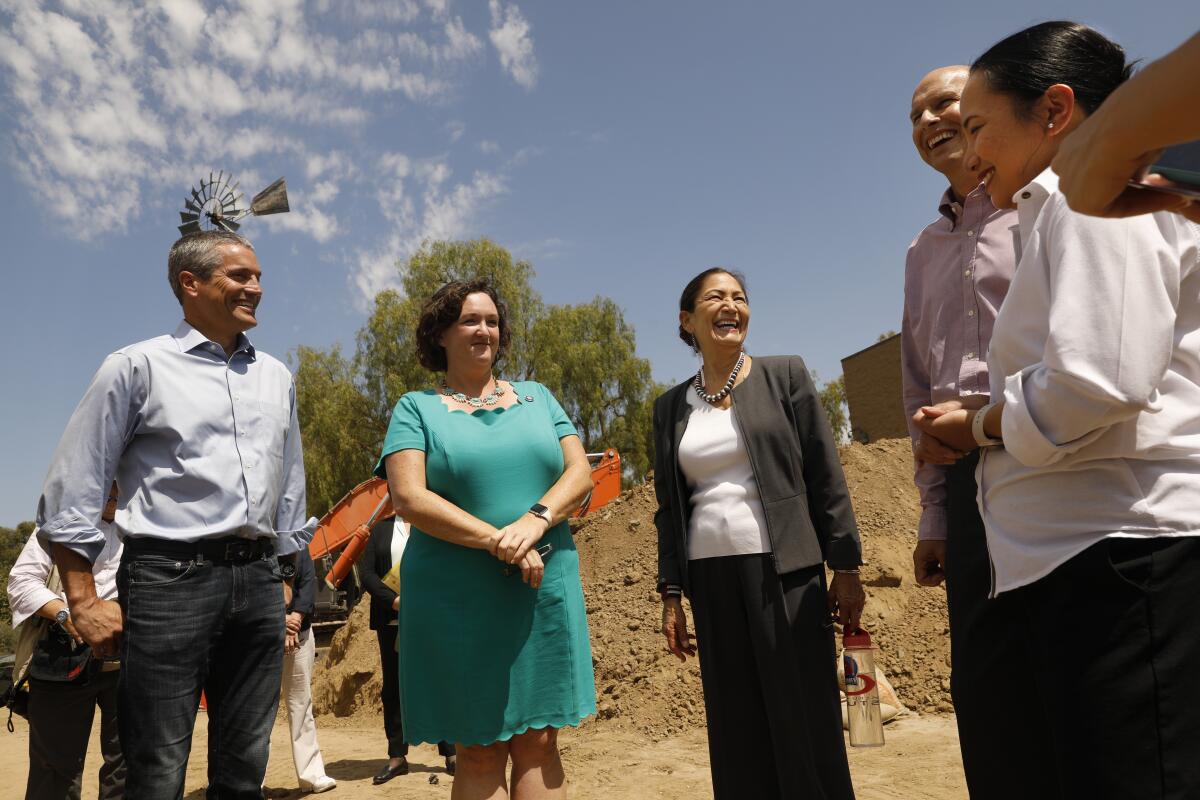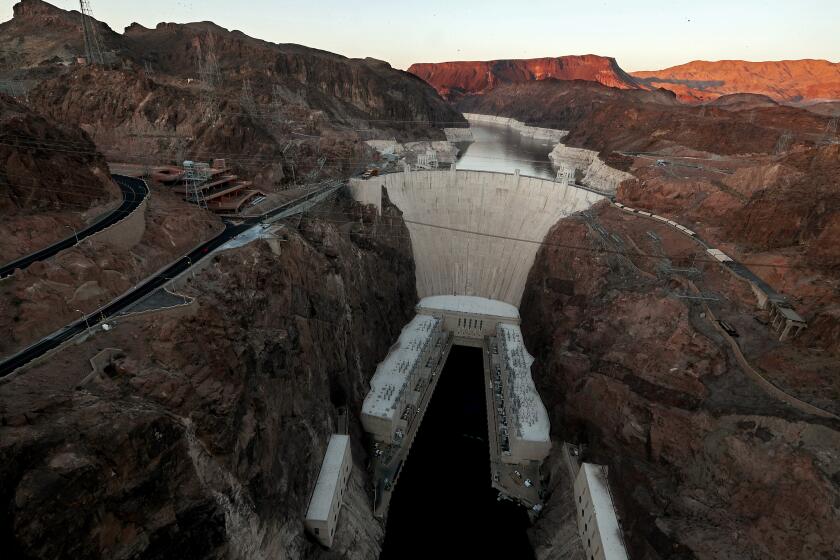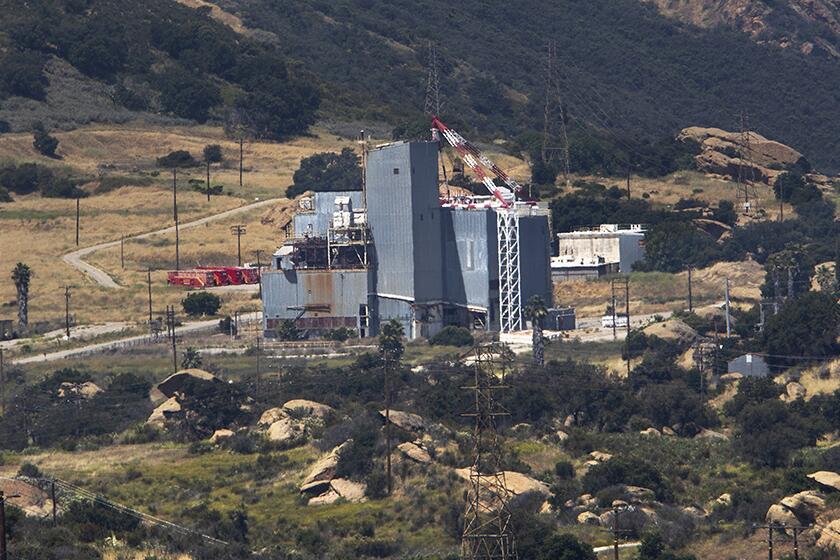Federal officials announce $310 million in funding to combat ‘megadrought’

- Share via
On a tour of increasingly parched California on Thursday, U.S. Interior Secretary Deb Haaland visited a water recycling project in Irvine to tout her department’s allocation of more than $310 million to combat a Western “megadrought” fueled largely by climate change.
Joined by Rep. Katie Porter (D-Irvine) and U.S. Bureau of Reclamation Commissioner Camille Calimlim Touton, Haaland stood before heavy equipment at the Syphon Reservoir Improvement Project and said she felt “overjoyed” to announce the funding of 25 water recycling projects, 20 of which are in California.
“These projects will advance drought resilience by bolstering water reuse and recycling techniques while supporting over 850,000 people in providing clean, reliable drinking water to families throughout the West,” Haaland said.
The federal government has announced a tier 2 emergency based on Lake Mead water levels, requiring reductions for Arizona, Nevada and Mexico.
Haaland’s announcement comes a week after Gov. Gavin Newsom warned that California could stand to lose 10% of its water supply by 2040. The governor released a pledge to revamp the state’s strategies to meet the challenges of a “hotter, drier future,” including boosting its water recycling capacities.
The funding announced Thursday will come from the bipartisan infrastructure bill that President Biden signed last year. It allocated $8.3 billion to the Bureau of Reclamation for water infrastructure projects.
The Irvine Ranch Water District’s Syphon Reservoir Improvement Project, which seeks to store enough recycled water to meet future needs, is set to receive $12.2 million from the Interior Department; the district serves 500,000 customers.
Porter called the Irvine Ranch Water District a “national leader” in the effort to conserve and expand water supplies. She applauded the funding allocation announced by her former congressional colleague.
“The longer we wait to take action,” Porter said, “the harder and more expensive it will become to solve both the water crisis and climate change.”
Paul Cook, general manager of the Irvine Ranch Water District, described the project as a large undertaking that would entail four years of construction before being completed by 2028.
The agreement requires Boeing to monitor stormwater runoff for 195 pollutants after the company completes a cleanup of the Santa Susana Field Lab.
Another water official, however, voiced frustration over how the federal government awarded assistance, and said there needed to be a “new paradigm” for grants in the face of recurring drought.
“$310 million does not provide new water supply, and we are running dry in California,” said Steve Sheldon, president of the Orange County Water District. “Instead of sprinkling multimillion-dollar grants to projects that by and large will already be built, our federal and state government should prioritize funding and expedite approvals to construct large-scale water supply facilities that under existing circumstances would not be constructed.”
Sheldon said that currently, in order for projects to apply for grants, they must have an approved environmental impact report, which he said can cost millions of dollars. Most water districts will not spend that money unless they are relatively sure that they will go forward with the project, he said.
Water infrastructure in the western United States has become an increasingly urgent focus as the region struggles through the driest 23-year period in 1,200 years.
Recently, the Bureau of Reclamation invoked previously negotiated water cuts to Arizona, Nevada and Mexico after Colorado River basin states failed to agree on water usage reductions ordered by the Biden administration. And, as the drought is expected to continue, many of the projects slated to be boosted by Interior Department funding won’t be operational for years.
At Thursday’s press conference, Wade Crowfoot, California secretary for natural resources, urged Californians to reduce their water usage in the meantime.
He said that despite “some slow starts,” Californians were making progress. In July, he said, residents had cut water use “upwards of 10%” compared with 2020 — the first year of the drought. Newsom, however, has asked urban water users to voluntarily cut back by 15%
When asked by reporters about how close California is to mandatory statewide cuts, Crowfoot acknowledged that “all options are on the table.”
The Interior Department announcement also came on the heels of Biden signing the Inflation Reduction Act into law, which officials lauded at the Irvine press conference. The legislation includes $4 billion to address the water crisis along the Colorado River.
Haaland touted both laws as representing the “largest investments in drought resilience” in the nation’s history.
“Water is essential to everything we do,” Haaland said. “None of us can live without it. It powers our economy, sustains our environment and, quite frankly, keeps us alive.”
More to Read
Sign up for Essential California
The most important California stories and recommendations in your inbox every morning.
You may occasionally receive promotional content from the Los Angeles Times.













